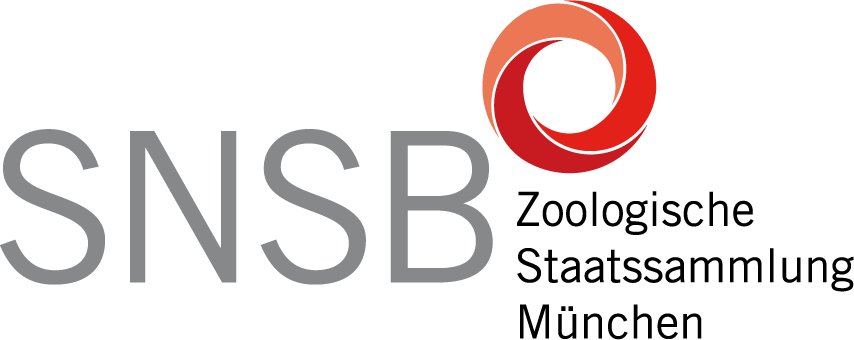Lepidoptera
Collection size, digitization
The ZSM collection of butterflies and moths actually includes about 12,000,000 specimens, representing far more than 130,000 species, stored in more than 80,000 drawers. Several private collections have already been donated to the ZSM, but are currently still under the curation of the private owners. More than 4,000,000 specimens (museum Thomas Witt) have been donated to the ZSM in 2010 and 2011 or are associated – as a public foundation – to the state collections. Hence, the Lepidoptera collection in Munich is by far the largest collection of butterflies and moths in Germany, and also on international scale it is one of the most outstanding and important collections. The collections are characterised by optimal conditions, guaranteed by modern technology of the building, by storage in large collection magazines, by high degree of order and by easy accessibility due to a nearly complete IT-based inventory of species. Thousands of historical specimens from original descriptions, the ‘name-bearing types’, are housed in Munich, a more exact number may soon be provided by the progress of the IT-inventorying. In the case of the >3,300 holotypes of the Museum Witt (with >87.000 paratypes) the inventory and web-presentation is complete.
Focuses
Focuses of the collection are in the Rhopalocera (butterflies) and Geometridae. ‘Bombyces and Sphinges’ are extremely well represented in the Museum Thomas Witt (see homepage of the MWM). The recent bequests of the six outstanding collections Klimesch, Eitschberger, Pröse, Deschka, Derra and Grünewald, brought, with approximately 600,000 specimens, a reasonable increase also in the Microlepidoptera. Further important collections: Historical collection of Esper (from the years 1770-1805), Herbulot (with historical collections of Mabille, Rambur, Chrétien, D. Lucas), Daumiller, Bastelberger, Disqué, Dannehl, Alberti, Eisenberger, Gehlen, Hirmer, Hörhammer, Koehler, Lukasch, Osthelder, Vogl, Speckmeier, Beyerl, Wolfsberger, Kager, Hinterholzer, Politzar, Behounek, Hacker, Scheuringer, Wegner, Darge, Ochse, Vitale, Taschner, Oswald, Müller, Zahm, Conde de Saro, van Schayck, Brechlin, Beeke, Löbel, Stadie, Fiebig, May, Weigert. Regional focusses of the collection are Germany, the Mediterranean region, Nepal (with ca. 500,000 specimens collected by the ZSM expeditions of Dr. W. Dierl), Sumatra (mainly material of the Heterocera Sumatrana Society), Taiwan (from own collecting), Laos (TW foundation), Africa (Tanzania: Ph. Darge; South Africa: H. Staude / own collecting; Ethiopia, Mali, Guinea, Congo: G. Müller, R. Beck, B. Fruth and others) and South America (historical specimens of H.H. Princess Therese of Bavaria, much material from cooperation projects and collecting by Dr. W. Forster and the ZSM project ‘Panguana’).
Research
Research is actually focused on systematics and taxonomy (morphological and molecular, e.g. DNA barcoding and molecular phylogeny) of the families Geometridae and Pyralidae, research is collection based and supported by a number of externally granted, major research projects (e.g. iBOL; BFB Barcoding Fauna Bavarica; GBOL; EU-Horizon-BGE). In the public international database for DNA sequence data (BOLD, Canada) the SNSB/ZSM acts as the (worldwide) second-best supplier of DNA barcodes, with 120.000 sequenced Lepidoptera as the most important contribution from the ZSM collection. One successfully sequenced ZSM-type-specimen from the year of 1788 may constitute the world record for the most ancient DNA bacode. In various cooperation projects with partners from all over our planet these data are used for research in nature sciences and in multiple applications.
The purpose of collecting … and why so many?
We can only love, appreciate and esteem what we know (St. Augustine). Hence, knowledge and investigation of nature is essential for appreciating and conserving species and habitats on our planet. Our collections document biodiversity in a sustainable and reliable way as the prerequisite for biological research.
In this context, Lepidoptera (butterflies and moths) are one of the most species-rich groups of animals with close to 200,000 described species and an estimated additional number of perhaps more than 300,000 undescribed species. In collections hundreds of specimens per species are needed for reliably and completely documenting all relevant aspects for any given species, as e.g. intraspecific variation of colouration and structure, sexual dimorphism, geographic and altitudinal distribution, increase or decline in population size, seasonal peaks of abundance, habitat preferences etc.. As a consequence, a „complete“ collection of Lepidoptera of our planet should at least include 200 x 500.000 = 100M vouchers. Lepidoptera are an outstanding model group for multiple research projects in nature sciences, because of their big diversity of specific life histories occupying a very broad range of habitats (except for oceans and poles).
Finally, butterflies and moths are percieved and appreciated by the public with much sympathy, why they are particularly predestined for outreach and for the mediation of contents and results from nature sciences, e.g. species extinction, ecology, nature conservation, evolution a.s.o.


